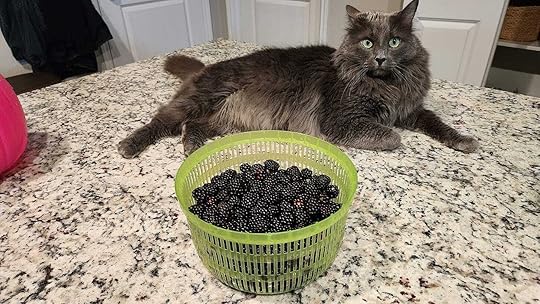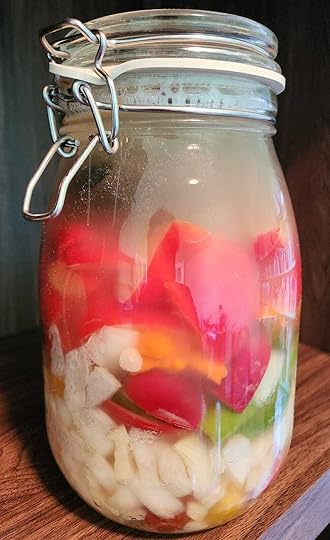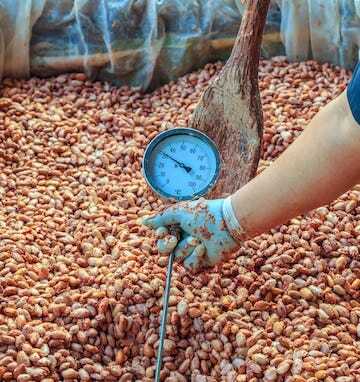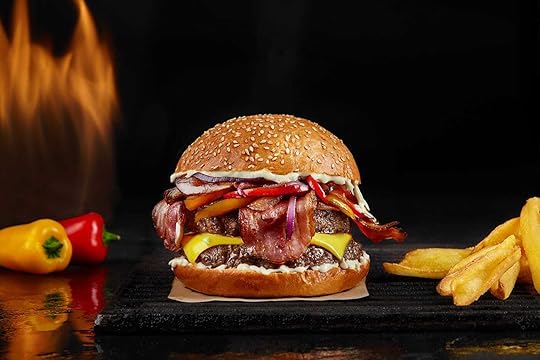Cliff Jones Jr.'s Blog
February 20, 2025
Introduction to Stonesong
This is your sneak peek at a language I constructed for my upcoming novel The Lasting Lands. It doesn’t play as big a role in the book as the Martian dialects (Gnomish, Ogrish, Elvish, and Impish), but this one is my clear favorite. It’s the product of over twenty years of tinkering, and I’m thrilled to finally be able to share it with you.

The main goal here is to simplify the grammar as far as it’ll go. It’s a bit of an experiment, so bear with me, and let me know what you think.
1. Spelling and PronunciationSyllable structure in Stonesong is much simpler than it is in English: Just an optional consonant (the onset), a vowel (the nucleus), and another optional consonant (the coda). There are also fewer possible contrasting speech sounds (phonemes) than in English, so spelling can be totally consistent with one letter per sound.
You’ll notice some variability in the following examples. Don’t worry too much about that right now. Just aim for the sound in the first example word.
p /p/ as in “pot” or “spot”
t /t/ as in “tap” or “stop”
q /k/ as in “cat” or “skull”
b /b/ as in “bat”
d /d/ as in “dot”
g /g/ as in “gap”
m /m/ as in “map”
n /n, ŋ/ as in “nap” or “song”
f /f/ as in “fan”
s /s, ʃ/ as in “sap” or “ship”
v /v/ as in “van”
z /z, ʒ/ as in “zipper” or “measure”
r /ʁ, ɹ, w/ as in “rat” or the French “rouge”
l /l/ as in “lap”
i /i, ɪ/ as in “feet” or “sit”
u /ɯ, ʊ, ə, ∅/ as in “foot” or “sofa” or silent
e /e, ɛ/ as in “bail” or “bear” or “bed”
o /o, ɔ/ as in “bowl” or “bore”
a /a, ɑ/ as in “father”
Putting these sounds together yields words like “lat” (“milk”), “qaf” (“coffee”), and “qafe” (“cafe”). Generally speaking, stress falls on the final vowel in a word that isn’t a U, so “qafe” sounds a lot like its English equivalent. The word “tabul” (“table”) also has the same stress pattern as its English equivalent, though its first vowel sound is different. (It sort of rhymes with “cobble.”)
New words in this section:
lat = milk
qaf = coffee
qafe = cafe, casual restaurant
tabul = table
2. Connecting WordsNearly all the words in Stonesong are essentially nouns. That is to say they name things, people, places, and other concepts. To think about verbs and adjectives in this way, consider their noun forms as primary (like “walking” and “slowness” as opposed to “walk” and “slow”).
So how can we put two nouns together? The clearest, most consistent way to do this is by putting a preposition between the two nouns. The English phrase “price of milk” becomes “qot du lat” in Stonesong. “Walking speed” can be rephrased as “speed of walking,” which would translate to “ve du qam.”
The word “du” (“of”) here is our first non-noun in Stonesong! It’s extremely common, but “u” (“with”) is even more basic. This particle (another term for these little connecting words) has such a special status that it’s silent and unwritten in most cases. So to say “coffee with milk,” we would have “qaf u lat,” but this can actually be shorted to just “qaf lat.” Whenever two nouns appear in sequence, you can always think of the word “with” coming between them.
Notice that “u” and “du” have complimentary meanings, so a phrase like “qaf lat” (“coffee with milk”) describes something similar to “lat du qaf” (“milk in coffee”).
The phrase “walking with slowness” would translate to “qam lag.” You might also translate this as “slow walking” or “walking slowly.” Depending on context, this same short phrase can be a complete sentence: a command to “walk slowly” or a statement that someone is walking slowly or has walked slowly in the past. When details such as pronouns and verb tenses can be understood from context, there is no need to spell them out in every sentence.
Stonesong has very few true prepositions, but it allows for the easy creation of such phrases, so learning new prepositions essentially means learning new nouns to drop into a few preset patterns. Here are some common examples:
su = being (participle)
se = focus, theme, content, topic, center
se su = about, focusing on, of (showing theme)
su se du = being the focus/theme of
lo = place, location
lo su = at, with a location of
su lo du = being the location of
te = time, moment, instance
te su = at (a specific time), in (a general time)
su te du = being the time of
oz = source, origin
oz su = from, with a source of
su oz du = being the source/origin of
go = goal, objective, target, destination
go su = for, to, toward, until, with a goal of
su go du = being the goal/objective of
ma = size, largeness, being big, magnitude
ma su = with a size of
su ma du = being the size of
mi = smallness, being little
Notice that all the particles we’ve covered so far (the words that aren’t simply nouns) follow a very specific pattern: Their only vowel is always U, which as we’ve covered doesn’t normally take stress. So a phrase like “ma su” can sound a bit like the English word “mass,” and the phrase “su lo du” can sound a lot like “slowed.” The sound represented by the letter U is so weak that it’s essentially optional.
This is a lot of explanation to take in without concrete examples of how you’d actually use these particle words and phrases, so let’s see what sentences we can come up with so far:
Qafe lat. = The cafe has milk.
Se su qaf. = Its focus is coffee.
Tabul ma. = The table is big.
Tabul lo su qafe. = The table is in the cafe.
Tabul oz su qafe. = The table is from the cafe.
Qafe su oz du tabul. = The cafe is where the table came from.
Lat qot mi. = Milk is cheap.
Tabul ma u qot ma. = The big table is expensive.
Of course, these are loose translations, and other interpretations are possible. None of these Stonesong sentences include any pronouns (“I”, “me,” “you,” “they,” etc.) or determiners (“the,” “a,” “this,” “my,” etc.), so that information has to be filled in from context. Stonestong also makes no grammatical distinction between complete sentences like “The table is big,” and noun phrases like “big table,” so either translation is valid.
Pay special attention to the last two example sentences here. When you place a word like “ma” (“size”) after something like “qot” or “tabul,” it means “with size”—in other words, “big.” And if you place a phrase like “qot ma” after a noun, it means “with a big price,” or “expensive.” Leaving “u” (“with”) unwritten, a modifier like “big” or “expensive” is taken to describe only the single word it follows. If you want it to describe a multi-word phrase like “tabul ma” (“the big table”), then you should include the “u” explicitly, as in the final example sentence. More on this handy little trick later.
A section on “connecting words” would be incomplete without translations of the most basic conjunctions used to connect words and phrases: “and” (“tu”) and “or” (“ru”). For example, you could translate “The table is big and expensive,” to “Tabul ma tu qot ma.” You can remember that “tu” means “and” by comparing it to the Latin “et,” as in “et cetera” (“and so on”).
New words in this section:
du = of, belonging to, by, being the state/attribute/focus of
go = goal, objective, target, destination
lag = slowness, sluggishness, languidness
lo = place, location
ma = size, largeness, being big, magnitude
mi = smallness, being little
oz = source, origin
qam = walking
qot = cost, price
ru = or, and/or
se = focus, theme, content, topic, center
su = being (participle)
te = time, moment, instance
tu = and, but
u = with, having a state/attribute/focus of, plus, of
ve = speed, quickness, velocity, rapidity
3. Nouns and PronounsPronouns are some of the most common words in English, so it may come as a shock when I tell you that a language can work just fine without them. For now, let’s limit discussion to third-person pronouns like “he,” “she,” “they,” and “it.” Anytime one of these words is used, it’s standing in for a noun phrase like “the boy,” “the woman,” “that person over there,” or “the main problem with our economic system.” In every case, you can boil this noun phrase (the pronoun’s antecedent) down to a single noun at the core of the phrase (“boy,” “woman,” “person,” and “problem,” respectively).
So in theory, we could say something like, “That person over there thinks person is famous,” and avoid the whole issue of which pronoun to use when we don’t know (or care about) the person’s gender. The big problem with using this method in English is that a determiner like “the” can never just be implied for a noun like “person.” If you leave the determiner off, it’s ungrammatical. And if you add it on, “the person” would indicate a different person from the subject of the sentence because English requires pronouns.
Stonesong doesn’t have this problem. As you’ve already seen, nouns can easily carry an implied determiner. Imagine an English speaker saying something like, “Cat outside,” and then “Cat just climbed up a tree.” This sounds pretty informal and perhaps nonstandard, but it’s easy enough to follow. It’s not 100% certain, but what the speaker probably means is, “There’s a cat outside,” and “The cat just climbed up a tree.” Context is important.
A central principle of Stonesong is that you shouldn’t be forced to add information (like “a” vs. “the” or “he” vs. “she”) just to meet some arbitrary grammatical requirement. If you want to be vague, be vague. You can add in all the detail you want for clarity, but this should be optional.
All that being said, here are some very basic nouns that can be used like pronouns. The only real difference between these words and actual pronouns is that you can also attach modifiers like “ma” (“big”) or “ve” (“fast”) just as you would with any other noun.
om = person, they/them
fem = woman, girl, lady, she/her
mas = man, boy, guy, he/him
zov = child, kid
beb = baby, infant
zo = animal
qat = cat
qan = dog
maq = machine
vel = vehicle, car
qop = computer
so = thing, stuff, entity, substance, matter, it
i = things, entities, matters, they/them
Except for the very last item in the list, all of the nouns here appear to be singular. But actually, they could just as easily carry a plural meaning if that were implied by context. In order to explicitly specify more than one of something, you can add “su i” to the noun you want to modify. You can also turn it around and put “i su” before the noun. The order isn’t so important when using “su” (“being”).
So the word “children” could translate to “zov su i” or “i su zov”—or just “zov” depending on context. To refer back to these children with something like a pronoun, you’d either say “zov” or “i” (probably whichever word came first in the antecedent phrase.
When you have a phrase that you want to join together so it behaves as a single word (maybe to form a name, for example), this can be done using a hyphen as in English (e.g., “zov-su-i”). But to fuse the word even more tightly together, You can use apostrophes instead. However, when an apostrophe would come between two consonants, it’s not needed since Stonesong roots never include consonant clusters. And when an apostrophe would follow the letter “u,” you can omit the “u,” so instead of “zov’su’i,” you’d have “zovs’i.” It’s clear how to break this word down into its three roots (“zov su i”), so no information is lost. For a phrase like “i su zov,” you’d need two apostrophes, but by convention, an apostrophe following a vowel can be rewritten as an accent mark. So “i’su’zov” becomes “ís’zov.”
So far, we’ve just been relying on the implied “the” meaning inherent in Stonesong nouns by default. But of course there are situations where you’ll want to specify this one, that one, some nonspecific one, and so on. These reference words behave like ordinary nouns in Stonesong and can all be used like pronouns as well.
li = this (here), here, they/them
le = that (there), there, they/them
la = that (over there), over there, they/them
al = some, something, somebody, one
qal = any, anything, anybody
to = every, each, everything, everybody, all
no = no, none, nothing, nobody, zero
We’ve pretty well covered third-person pronouns at this point, so let’s come back to the first and second person. The Stonesong word “vo” means “you,” with the number of people being unspecified, just as in English. Similarly, Stonesong’s first-person pronoun “me” can mean “I,” “me,” “we,” or “us.” As we’ve just covered, it’s possible to make either of these words explicitly plural, so “me su i” (or “més’i”) means “we/us,” and “vo su i” (or “vós’i”) means something like “you guys” or “y’all.”
Or if you want to say “we” in a way that’s clearly inclusive of the listener (i.e., both first and second person together), that would be “me vo” or “vo me,” depending on your focus. You can also combine pronouns with “tu” (“and”) just as you would in English.
New words in this section:
al = some, something, somebody, one
beb = baby, infant
fem = woman, girl, lady, she/her
i = things, entities, matters, they/them
la = that (over there), over there, they/them
le = that (there), there, they/them
li = this (here), here, they/them
maq = machine
mas = man, boy, guy, he/him
me = I/me, we/us
no = no, none, nothing, nobody, zero
om = person, they/them
qal = any, anything, anybody
qan = dog
qat = cat
qop = computer
so = thing, stuff, entity, substance, matter, it
to = every, each, everything, everybody, all
vel = vehicle, car
vo = you
zo = animal
zov = child, kid
4. NumbersIn the last section, we covered how to make nouns explicitly plural, but what if you want to make a noun explicitly singular? You’d just specify the number “one” (“o”). And if there are none of something, you’d specify “zero” (“no”). You can place the number before or after the noun it modifies, connecting the two words with “su” just as you’d do with “i” to mark plurality. So “the cat,” “a cat,” or “one cat” would be “qat su o” or “o su qat.” “No cats” would be “qat su no” or “no su qat.”
Here are the basic numbers in Stonesong:
no = zero
o = one
do = two
ti = three
qa = four
qin = five
si = six
sep = seven
oq = eight
nef = nine
deq = ten
To keep on counting, you’d say “deq o” for “eleven,” “deq do” for “twelve,” and so on.
The particle “vu” means “times” or “multiplied by.” To form the number twenty, you could say “do vu deq” (“two times ten”), but by convention, multiplied numbers like this are fused into a single word. So “twenty” would be “dóv’deq,” “thirty” would be “tív’deq,” and so on.
“Forty-five” would be “qáv’deq qin.” Notice that the “forty” part being a single word means that the following “qin” (“five”) doesn’t need an explicit “u” (“plus”) to connect it to the rest of the number. If we had the phrase “qa vu deq qin” instead, “qin” would just connect to “deq,” yielding fifteen, so we’d have “four times fifteen,” which would be sixty. This is the reason for the convention of fusing numbers with “vu” together. It preserves the normal order of operations (multiplication before addition).
For very large numbers, the word “pu” is a handy particle meaning “to the power of” or “with an exponent of.” So “pu do” means “squared,” “pu ti” means “cubed,” and so on. Large numbers proceed as follows:
sen = hundred
qil = thousand
qilp’do = million
qilp’ti = billion
qilp’qa = trillion
qilp’qin = quadrillion
qilp’si = quintillion
Following the patterns laid out here, you can construct numbers as large as you want. For example, 123,456,789 would be read as “sen dóv’deq ti vu qilp’do u qáv’sen qinv’deq si vu qil u sepv’sen oqv’deq nef.” This is quite a mouthful, but no worse than English: “one hundred twenty-three million, four hundred fifty-six thousand, seven hundred and eighty-nine.”
New words in this section:
deq = ten
do = two
nef = nine
o = one
oq = eight
pu = to the power of, with an exponent of
qa = four
qil = thousand
qin = five
sen = hundred
sep = seven
si = six
ti = three
vu = times, multiplied by
5. Forming SentencesGiven what we’ve covered so far, take a look at the following translations.
Fem qan ma u go su qafe. = The lady with the big dog is headed for the cafe.
Fem qam ve ma. = She’s walking really fast.
Can you see how everything fits together here? The first sentence would literally translate to, “Woman with dog with size has goal being cafe.” And the next sentence literally says, “Woman with walking with speed with size.” Each new “with” of this sentence adds descriptive detail to the previous noun. But in the first sentence, we have an explicit “u,” which indicates that “go su qafe” (“the goal being the cafe”) describes “fem qan ma” (“the lady with the big dog”) instead of just “ma” (“size”).
If we want to leave out the “fem” of the second sentence, that’s perfectly acceptable. It would be a little unclear whether the woman or the dog is walking quickly, but pronouns are not grammatically required in Stonesong, and vagueness is okay. We could also begin the sentence with “qam” (“walking”) and then specify who’s doing the activity later.
Qam du fem u ve ma. = Her walking is really fast.
Qam ve ma udu fem. = Really fast walking is being done by her.
We haven’t covered word “udu” yet, but I’ll bet you can figure it out. It’s exactly like what we did with making “u” (“with”) explicit to show it connecting to more than just the single noun it follows. “Udu” has the same meaning as “du” (“of”), but it describes the phrase “qam ve ma” (“really fast walking”) instead of the single word “ma” (“size”). You can extend this practice to any particle by prefixing it with the letter U (e.g., “usu,” “utu,” “uru,” etc.).
Stonesong doesn’t distinguish between nouns and verbs grammatically. It only has two parts of speech: content words (basically nouns) and particles (basically prepositions). Some words name activities (like “qam”), and others name qualities (like “ve”), and when these function as the core of the sentence they behave a lot like verbs.
To start creating a variety of sentences in Stonesong, here are some really basic verb-like words:
es = being (state), existing, existence, yes
ta = staying, remaining, standing (in place)
va = going, coming
fa = doing, performing, action
faq = making, constructing, production
av = having, possessing, possession
des = wanting, desire
nes = needing, necessity
gos = liking, enjoyment, fondness
am = loving, love
po = being able, ability, capacity, potential
qom = eating
bev = drinking
vi = seeing, watching, looking, vision
od = hearing, listening
sa = knowing, knowledge
qog = thinking, thought, cognition
di = saying, speaking, talking, telling
don = giving, donation
gan = getting, obtaining, receiving, gaining
Stonesong grammar is less about subjects and objects and more about how each participant in a given action connects to the verb-like word using a preposition-like particle or phrase. As we’ve seen, you can communicate a lot using the basic particles “u” and “du,” but these words are pretty vague, so you’ll need a bit more vocabulary to show more precise thematic roles of verbal participants:
aq = doer (of an action), actor, agent, force
aq su = by (showing authorship), being done by
su aq du = doing, performing, being the doer of
ot = instrument, means, tool, utility
ot su = with (showing means), using, by means of
su ot du = facilitating, being the means of
ep = experiencer, beneficiary (of an action)
ep su = affecting, for (showing beneficiary)
su ep du = being affected by, being the beneficiary of
qo = cause, reason, motivation
qo su = because, since (showing cause), with a cause of
su qo du = so (showing effect), therefore, being the cause of
fe = effect, result
fe su = so (showing effect), therefore, with an effect of
su fe du = because, since (showing cause), being the effect of
Bringing all of this together, here are some examples of these participant roles in action. Notice that there are subtly different ways to say essentially the same thing. It’s up to you how much precision you want to use and where you want to put the focus.
Me am vo! = I love you!
Me vi qat. = I see a cat. (Me with a view of a cat.)
Me vi se su qat. = I see a cat. (Me with my vision focused on a cat.)
Vi ep su me u se su qat. = I see a cat. (Vision with an experiencer of me and its content being a cat.)
Mas bev qaf. = The man drinks coffee.
Qaf su se du bev aq su mas. = Coffee is what he drinks.
Nes don go su zov udu qop. = We have to give the kid a computer.
Qat tu qan u gos qom tu bev. = Cats and dogs like to eat and drink.
Om od fe su sa. = The person listens, so they know.
We could go on and on coming up with sentences using this limited vocabulary, but you get the idea. Our next step is to broaden the kind of sentences you can produce by introducing the Stonesong equivalent of different verb forms (tenses, questions, modals, etc.).
New words in this section:
am = loving, love
aq = doer (of an action), actor, agent, force
av = having, possessing, possession
bev = drinking
des = wanting, desire
di = saying, speaking, talking, telling
don = giving, donation
ep = experiencer, beneficiary (of an action)
es = being (state), existing, existence, yes
fa = doing, performing, action
faq = making, constructing, production
fe = effect, result
gan = getting, obtaining, receiving, gaining
gos = liking, enjoyment, fondness
nes = needing, necessity
od = hearing, listening
ot = instrument, means, tool, utility
po = being able, ability, capacity, potential
qo = cause, reason, motivation
qog = thinking, thought, cognition
qom = eating
sa = knowing, knowledge
ta = staying, remaining, standing (in place)
va = going, coming
vi = seeing, watching, looking, vision
6. Verb Forms and NegationWhen talking about verbs, the word tense is often used very loosely. Properly speaking, it describes when an action occurs in time (i.e., past, present, or future). Related concepts are aspect (whether the action is recurring, ongoing, etc.) and mood (the speaker’s attitude about the action and whether it’s real or hypothetical). In Stonesong, all indicators of tense, aspect, and mood are optional depending on context. Take the following examples:
Qam. = I walk. (Or possibly “I’m walking,” or “I walked,” etc.)
Qam te su za. = I’m walking (now).
Qam te su pa. = I walked (in the past).
Qam te su fo. = I’m going to walk (in the future).
These are all fine ways to situate your actions in time, but even more useful are three little aspect markers: “a” (showing progress), “ab” (showing habit), and “e” (showing completion). And here, some combinations are possible.
Qam a. = I’m walking. (Or “I was walking,” etc.)
Qam ab. = I walk (regularly).
Qam e. = I walked. (Or “I’ve walked,” etc.)
Qam a e. = I was walking (but I’m done now).
Qam ab e. = I used to walk (but I don’t anymore).
Qam ab te su fo. = I’ll start walking (regularly in the future).
This brings us to mood, the most common example of which is indicative vs. interrogative, or a statement vs. a question. If I say “Des qom,” the most likely interpretation without knowing the context is that I’m hungry (literally, “I want to eat,”). If I make it a question (“Des qom?”), you’d guess purely by my intonation that I’m asking if you’re hungry. Just like you can optionally add in pronouns like “me” and “vo” to make things more clear, you can also specify whether something is a question or not using actual spoken words, not just intonation:
Re du me des qom. = I want to eat.
Qe du vo des qom? = Do you want to eat?
Vo des qom qi? = What do you want to eat? (No need for “qe” when “qi” is present.)
As you can imagine, statements about reality (“re”) are extremely common, so this marker is mostly just used for contrast or emphasis. Other common moods include the subjunctive (hypothetical or conditional) and imperative (requests or commands).
Ip du gos qaf. = I would like some coffee (if you have any).
Pe du bev tu gos! = Drink and enjoy!
The last point I’d like to cover in this very long-winded introduction to Stonesong is how to make things negative using the equivalent of the English word “not.” There is one thing I’d like you to consider first though: If I say, “I don’t like coffee,” does that mean I actively dislike coffee or that I don’t care about it one way or the other? English is ambiguous here since “not” can be used to mean there’s none of something (no liking of coffee) or the opposite of something (disliking of coffee). Stonesong has you covered here with the words “no” (zero or none) and “ne” (negative or opposite).
No su gos qaf. = I don’t (particularly) like coffee.
Ne du gos qaf. = I dislike coffee.
Remember that verb-like words in Stonesong are really just nouns, so this pattern can be applied the same way anywhere you like. For example, “no su am” would be the absence of love, and “ne du am” would be love’s opposite: hate. “No su bon” would mean “not good,” but only “ne du bon” would mean actually “bad.” “No su ami” could refer to anyone who’s not a friend, such as a stranger, but “ne du ami” would refer to an enemy.
I could go on and on, of course, but this seems like a good place to bring this introduction to a close. Please post any questions you have in the comments. I’ll make more vocabulary and grammar points available soon, but how soon will depend on how much interest I see in the language. Until then! Gós’fo!
New words in this section:
a = progress, continuous (aspect)
ab = habit, repeated (aspect)
ami = friend(s)
e = completion, unitary (aspect)
fo = future (tense), then (future), later
bon = goodness, being good
ip = hypotheticality, subjunctive (mood)
ne = opposite, inverse, negative (value)
pa = past (tense), then (past), before
pe = instruction, requesting, imperative (mood)
qe = question, interrogative (mood)
qi = what, which, who
re = reality, indicative (mood)
za = now, present (tense)
November 22, 2024
My Next Book: The Lasting Lands
I’m a linguist and software developer obsessed with “dreampunk,” the weird hippie cousin of cyberpunk. Among other projects—notably Mirrormaze (2020), Dreck (2023), and Somniscope (2024)—I’ve spent the past decade crafting a 106,000-word science fantasy novel to live in the space between Terry Pratchett’s Tiffany Aching books and the animated miniseries Over the Garden Wall, with just a touch of James-S.A.-Corey-style space opera thrown in.

THE LASTING LANDS is a story about stories, how they come to life and grow into something beyond their authors’ understanding or control. In the novel, we follow ten-year-old Adelaide Batiste—as well as her “sister” Ada, who lives inside her head—down a rabbit hole into an ancient Martian civilization. The tale starts off strongly reminiscent of both Alice’s Adventures in Wonderland and The Wonderful Wizard of Oz, but over the course of three distinct “books,” its point of view fractures into multiple threads, and we gradually find ourselves in a collection of connected tales spanning multiple centuries and layers of reality. Through it all, Adelaide struggles to find peace and reunite with her family while Ada’s true identity and eerie abilities call everything into question.
So what do you think, folks? Do I have a shot at finding a literary agent for this? I’d really like to go all out on this one with a big release and an audiobook and translations and everything. Please let me know if you have any agent recommendations because the hunt is on.
November 14, 2024
Color-coded emotional cycles
Everything happens in cycles. This is such a common recurring pattern that it’s fun to apply it to very different domains and see how things correspond and match up with each other. More on this later, but for now, let’s look at some basic emotions:

🟢 Happy
🟡 Excited
🟠 Afraid
🔴 Angry
🟣 Sad
🔵 Calm
Generally speaking, one feeling leads to the next, and then it all starts over. For what it’s worth, I try to stretch out the best parts and power through the worst parts. Always remember that the bad parts will end and the good parts will come again. (And try not to worry that the reverse is also true.)
Here’s a specific application of this cycle with things you can do:
🟢 Appreciate the good things in your life.
🟡 Anticipate good things yet to come.
🟠 Consider dangers to avoid.
🔴 Acknowledge injustice and cruelty in the world.
🟣 Remember that everyone you love will die.
🔵 Get some rest.
November 12, 2024
Folk Punk?!
Some years back, I remember coming up with this term to describe what I thought was a nonexistent genre of music I’d enjoy. Why I never bothered to look “folk punk” up and see if there were any bands describing themselves this way, I’ll never know. Folk punk exists, and it is glorious.

Starting back in middle school (way back in the nineties), I started listening to punk CDs from the mall, downloading a bunch of MP3s, and eventually (when I got my license) driving to Fitzgerald’s in Houston for punk shows. Before that, I'd mostly been raised on Bob Dylan, The Beatles, and Creedence Clearwater Revival. All that combined with the fact that I grew up in the woods of rural Texas goes a long way to explaining why my tastes have always gravitated toward folk punk (long before I knew the genre’s name).
Up until my first year of college, when I discovered Neutral Milk Hotel, the band I listened to most consistently was probably Violent Femmes, definitely one of my favorites. And just now I looked up folk punk on Wikipedia and learned that they were one of the bands that started it all, along with The Pogues, who I've also loved since high school. Of course it makes sense. I’m so late to the party it’s not even funny. I have a lot of lost time to make up for.
If all of this is new to you too, then absolutely check it out! Here’s a little beauty to get you started.
October 14, 2024
A Brief Meditation on Combat
In the vast majority of attacks, the purpose is not to kill or even to wound but to show strength and thereby menace your opponent with the possibility of further attacks. The purpose of this threat is de-escalation. You want the fight to end quickly, and on your terms.
More often than not, when you have a single opponent, that opponent has allies who will witness the fight in some form or another. This means you are not truly fighting that single opponent but potentially the whole group. So even if your aim is to annihilate this first opponent, you must do it in a way that shows restraint and good form. You are demonstrating to your other potential opponents that you have much more power in reserve should they choose to continue the fight. Always offer them an out so they can stop fighting without losing too much face.

In this way, learning to fight well is literally the same as learning to minimize combat. I know this sounds like something right out of Kung Fu Panda, but it’s true. The goal isn’t to keep fighting until there is no one left to kill but to defeat your opponent as decisively as possible in a way that doesn’t lead to more fighting. This last point is crucial and helps to explain why wars never seem to end. There have to be voluntary rules of engagement, and they have be followed, or else it’s not war but mass murder. And murder tends to provoke revenge.
If you follow my posts, you may have seen that I recently got back into martial arts, and I did just finish a class this evening, but this meditation was actually inspired by an insult I received on social media earlier today. My response to it (after a good long delay to give my opponent time to cool down from their initial aggression) was targeted and effective but showed major restraint. Their response to this was better than I’d hoped for. A sincere apology with a brief explanation. It felt so much better than a flame war ending in a block. I definitely won, but the other guy didn’t lose. This outcome isn’t always possible, but it should always be the goal.
October 11, 2024
Fermentation Basics You Ought to Know
Until fairly recently, I’d always associated fermentation with alcohol (beer, wine, liquor…). I’d heard that certain foods were fermented (yogurt, soy sauce, chocolate…), but I didn’t really understand what that meant. What I was missing is that there are a few different types of fermentation, and they don’t all produce alcohol.
Fermentation is when microorganisms (yeast or bacteria) convert carbohydrates into something else, generally either an alcohol or an acid. Acids tend to have a sour flavor, which is why fermented foods are often pretty tangy. In the case of vinegar, this is extreme, but I’m getting ahead of myself. The important thing to remember is that some microorganisms (often called “bad bacteria”) want to eat your food and make it rot while other microorganisms just want to eat the sugar and maybe some starch. When the conditions are right, they actually take over and prevent the bad bacteria from growing, which can make your food last a lot longer.
In the following sections I’ll briefly describe the five main types of fermentation: alcohol, lactic acid, acetic acid, butyric acid, and alkaline.
Alcohol fermentation:
I got into this type of fermentation years ago as a way to make use of large amount of wild fruit available in our neighborhood: blackberries/dewberries and muscadine grapes mostly. All you really need to make wine out of fruit is some yeast and some clean water (either bottled or boiled to cut down on that bad bacteria). That and some materials to store the gloopy mess while it's fermenting and keep it from getting exposed to oxygen, which would make it sour.

In a nutshell, the process goes something like this:
Make sure the fruit is clean and mash it up in a large sterile container, preferably glass. Using frozen fruit is not bad as the freezing helps to break things down so the yeast can do its job a little easier. With fresh-picked fruit, this may actually help you out a lot because picking several pounds of blackberries (for example) is probably not a one-day endeavor. Freeze as you go and thaw when you're ready to start making wine.
Dissolve some yeast into warm water with a little sugar mixed in. After a while, it should get bubbly, which lets you know the yeast is alive and multiplying well. Mix that into your mashed-up fruit, and that should start bubbling pretty well before long. This is the live yeast eating the fruit’s sugar and producing carbon dioxide gas—as well as alcohol, of course.
You should leave this bubbling mixture exposed to air for three to five days for what’s called the primary fermentation. Just drape a towel over your container to prevent dust from getting in there.
Once this phase is complete, you'll want to filter out all the fruit pulp (as tricky as it sounds) and then leave the remaining juice (now wine, actually) doing the secondary fermentation for a few months until the bubbling has slowed way down or even stopped entirely. The yeast will go until the alcohol content hits around 15% or it runs out of sugar, whichever comes first. Some sort of air lock will be needed to let carbon dioxide escape without any oxygen coming in to spoil the wine. If you let the pressure build up, you’ll get bubbles like champagne or beer, but if the carbon dixoide can freely escape, your wine will be flat, which is normally what you want.
Once the fermentation is finally finished, you can siphon your wine into bottles. The yeast will have multiplied a lot by now, so you’ll actually see cloudy muck settled down in the bottom of your container. That’s the dregs. The yeast can be filtered out of this or kept in if you like, but generally speaking, the highest quality wine (or beer or sake or mead) will come from the top of your container which will be the clearest. The more you siphon your wine out (top to bottom), the cloudier it will get, and at some point, you may just want to dump the “bottom of the barrel.”
That’s basically how you make any kind of booze, actually, not just wine.
For beer, it’s more complex because you have to slow cook your grain to get it to break down and let some sugars out for the yeast to eat. This is the “malt“ you’ve heard of, really the most important part of beer. And then you probably also want hops for that bitter flavor. To get carbonation, you just bottle the beer with a little fermentation left to go. So you see you’re just playing with the formula a bit, but it’s the same basic process.
Although sake is often called “rice wine,” it’s technically a type of beer because it’s made of grain, not fruit. You’ll generally want a higher alcohol content and no bubbles with sake. And of course no hops.
My favorite booze to make is mead because it’s the easiest by far. And I love the taste of honey, so it’s win-win. Making mead is basically like making wine, but you don’t have any fruit to deal with, just honey, water, and whatever chunky spices you want to include. Mead is sometimes called “honey wine,” but it’s not made from fruit, so mead is really just its own thing.

“What about liquor?” you may ask. That's just a more concentrated form of some other alcoholic beverage. Brandy is made by heating wine at just the right temperature and capturing the alcohol as it evaporates, leaving the watery part behind (since water boils at a higher temperature than alcohol). This process is called distillation. For whiskey, you’d do the same thing with a strong, flat beer. Rum comes from sugar cane juice, tequila from agave nectar, etc. You can even make a liquor by distilling mead, and I for one would love to try it.
I’ll have to do another post on distillation because this section is getting out of hand.
Lactic acid fermentation, a.k.a. lacto-fermentation:
One of the oldest fermented foods is olives. At least 6,600 years ago, people around modern-day Haifa, Israel, were using seawater to cure olives, preserving them and reducing their bitterness. Actually, there's evidence of people in the same region making a sort of thick beer 13,000 years ago, so I guess that counts as food too. We’re talking prehistoric times for both, so our knowledge is a bit fuzzy. What we know for sure is that people have been using fermentation to preserve their food for so long that it’s literally a part of our DNA at this point.
I was recently able to grow a little garden for the first time in years, and the jalapeño peppers really took off. I used them up making roasted salsa a few times, but they just kept coming, and we had most of a head of red cabbage left over from making pozole, so I thought I'd make some sauerkraut and throw the peppers in there too (seeded and sliced). I’d never made sauerkraut before and was really surprised at how simple it was. This “pepperkraut” was my first-ever attempt at lacto-fermentation, and it turned out great. Don’t be scared! It's easy and safe.
All you have to do to let the “good” lactic acid bacteria (LAB) thrive and keep the “bad” bacteria at bay is get the water a little salty. Roughly a tablespoon of salt per cup of water, though this varies by the vegetable you’re trying to ferment. Again, you want to keep the container sealed up in a way that lets carbon dioxide out but doesn’t let oxygen in. If you don’t mind some bubbles, you can just use a jar with a lid that closes well and open it slightly every 12 hours or so to “burp” it. This is important though, so don’t forget. You wouldn’t want the thing exploding on you.

You’ll also want to keep your vegetables fully submerged in the brine, so you’ll probably need a stone, a glass weight, or a plastic bag full of water to rest on top and weigh everything down even as it bubbles. In a day or so, your jar should be bubbling nicely and the liquid should be starting to get cloudy. Keep that going for at least three days, maybe a week or two depending on what you’re going for. It’s super easy, incredibly healthy, and pretty darn tasty too!
Never throw out your brine with all that good live LAB in it. You can take a little shot of it for your gut health (sort of like Yakult or a probiotic supplement), or you can use a little of that brine to kickstart your next lacto-fermentation project. This is the same bacteria that makes yogurt, cheese, sourdough, traditional pickles, miso, kimchi, salami, pepperoni, and a whole lot more. It’s really versatile and a great way to unlock new flavors while preserving your food.
Acetic acid fermentation:
This usually just means alcohol fermentation plus exposure to oxygen to make vinegar. You’ve probably heard that if you open a bottle of wine (exposing it to the air) and don’t finish it fast enough, it’ll turn to vinegar. That’s true. The word vinegar comes from the Old French vyn egre, which literally means “sour wine.” This is why you have things like red wine vinegar and apple cider vinegar. They’re basically just alcoholic beverages that have gone bad.
Acetic acid fermentation is also an important part of making chocolate. After the cocoa beans are fermented with yeast and then lacto-fermented, they’re exposed to oxygen to produce acetic acid. This complex process is pretty magical. The Olmecs of what’s now southern Mexico figured it out around 3,500 years ago. And thank the Bird Monster they did! Chocolate is the most popular candy in the world, and it’s not even close.

Butyric acid fermentation:
As far as I can tell, this type of fermentation isn’t super important for home cooking. It happens some when you’re lacto-fermenting certain foods, but it’s done more on the industrial scale to produce buttery or fruity flavors. It’s also used in tobacco processing, leather tanning, pharmaceuticals, plastics, and gasoline. Yum!
Actually, this type of fermentation is really important for your health because it’s part of digestion. It happens in your colon when bacteria there ferment dietary fiber. Butyric acid regulates blood sugar and cholesterol, so it’s pretty dang important. But yeah, not so much for cooking.
Alkaline fermentation:
This last type of fermentation is pretty different from the rest. Here protein is broken down into amino acids and peptides, and ammonia is released, so it is not going to be to everyone’s taste. It’s a traditional practice in Asia and Africa. The only alkaline-fermented food I’ve tried is Japanese natto, made from soybeans. It looks nasty and slimy, and it tastes… Well, it’s definitely an acquired taste. But like most fermented foods, it’s really healthy for you.

I hope I’ve taught you something new here today. Why not expand your palate and go out looking for some fermented foods you haven’t tried yet? And for the truly adventurous, get to work on mastering the various fermentation techniques and producing things that nobody’s ever tried! Somebody has to be first, and without brave pioneers like that, we wouldn’t have beer or chocolate or probably most of your favorite foods. Godspeed!
October 7, 2024
The Foot Fist Way
When I was maybe 11 or so, back in the mid-nineties, I got into martial arts, and let me tell you: I loved it.

My family lived in a rural Texas town called Magnolia, and we didn't have much money. My older half-sister was living with our grandmother around this time, so it was just me, my parents, and my mostly non-verbal autistic younger brother (what you'd call “level 3 autism” these days).
I was autistic myself (level 1), but we didn't know that at the time, mostly because the definition of autism was much narrower back then. My parents had me try out different sports, but I was never really interested in them beyond just playing with a few friends in the yard. I got into martial arts after an incident where I was attacked by some older boys on the side of the highway.
What happened was that I used to ride my bike two miles or so down the highway from my neighborhood to the nearest grocery store (the nearest business of any kind, really). There was a wide shoulder, and it wasn't elevated or anything, so it was a fairly safe ride. In the store, I noticed three teenagers looking at me and kind of following me in a way I didn’t like, so I left in a hurry on my bike. Predictably (in retrospect), they followed me on their bikes, overtook me, and cut me off, forcing me to stop.
They tried to act friendly and convince me to go with them through a field beside the highway to a little wooded area around a pond, but I refused, knowing I’d be safer in full view of the passing cars. They told me they wanted the smallest one of them to learn how to fight, so he was going to fight me. I kept not responding to them and just trying to get back on my bike. Eventually, he just started punching me in the back and back of the head, but I didn't give them anything, and I was able to get on my bike and ride off, leaving them disappointed.
I didn't want to tell my parents what had happened, but it was pretty obvious I’d been through something, so my mom got it out of me. A cop came to our place (a mobile home on a one-mile loop in the woods off the highway), and I gave a description of the teenagers, but nothing came of it, of course.
So I began my studies of Northern Shaolin Praying Mantis Kung Fu.

Or at least that’s what my instructor Larry Brooks called it. It was also blended with karate, and we did sessions of jujutsu and tai chi as well. And on top of all that, we had a Korean flag up, which would imply some affinity with taekwondo, so it was definitely a hodgepodge.
I really enjoyed it though. My favorite part was probably all the stretching and meditation we did at the start and end of every class. (Young me would have loved yoga.) On occasion, we even devoted a full class to meditation. I remember the dojo had no windows, and one time the lights were out, so it was pitch black except for a candle in the middle of the room. This experience made its way into my short story “Sacred Geometry,” but I digress.

Not long after my parents divorced, I had to stop going to martial arts because we didn’t have the money for it. I was really disappointed, but I tried not to whine about it because I understood. If you can’t afford it, you can’t afford it. I'd made it to blue belt, and I was about to progress to purple, but we didn't have the money for the test, so that was it. Next would have been brown belt and then black.
Okay, I’ll admit it: I’m still angry I had to stop before I could earn that black belt. Not at my parents directly but at the situation. At that time in my life, I thought I’d eventually run a martial arts school of my own someday. It was important to me. This feeling reminds me of all the times my brother destroyed my artwork or held me under a blanket so I couldn’t get out or attacked me with punches and biting and headbutts. I couldn't be angry at him directly because he didn’t fully understand what he was doing. It wasn’t within his control.
I always planned to get back into martial arts, but I never had the money or the free time. And I had kids, so if anyone was going to get into stuff like that, it would be them. I tried to get my older girl interested, but she never went for it. My younger girl seemed up for it though, so as a birthday present when she turned five, I enrolled her in taekwondo. She told me many times it was the best birthday present ever.
My dad passed away at the end of last year, and since then we've been in the process of getting moved into his old house. My daughter stopped taekwondo for a while while we were in transition, but we recently picked it back up again at a new school. This one has full family classes where I can be in the same class as her.
And so after nearly thirty years… I’m back, baby!

April 15, 2024
The Magician’s Secret
Long ago, in the sprawling farmland south of Sun City, there lived a family by the name of Memphis: Big Ray, his boys Cyrus and Seth, and his daughters Nell and Isa. After their mother left town, the girls took on an increasingly motherly role despite being the youngest of the family. Nell in particular worked closely with her father to manage the farm, while the boys provided manual labor, and Isa learned to cook and clean.
Big Ray Memphis was known far and wide as something of a magician. He had an uncanny way with plants that few could understand and none could replicate. He talked to his crops and his trees, as many farmers do, but his plants actually listened. Or they seemed to anyway. It wasn’t the plants themselves responding to Big Ray, however; it was their legions of microscopic pixies, self-replicating relics of a bygone age when magic was still the servant of mankind, not yet its master.
Ordinarily, these tiny machines would operate on their own inscrutable design, but if you had the proper access credentials—like a secret name you’d state to prove your worth—then pixies would follow whatever commands you might give them.
Nell and Isa were like two peas in a pod, so close in age and appearance that they were often mistaken for twins. Both of them wanted to be just like their Daddy, with magical pixies at their command. Nell was good-hearted about it, but Isa resented Big Ray for keeping his secret name from them. If only he’d promised to tell them when they were older, Isa could have lived with that. But no, he’d make a speech all high and mighty: “The little folk know best. Meddling with their intelligence system always does more harm than good, one way or another. Trust the algorithm.” But the girls knew Big Ray still “meddled.” It was just that he didn’t trust anybody else with that kind of power.
One night, Nell came to bed looking like she had the whole world figured out. “I know how to get Daddy to spill his secret name,” she told Isa. “Out in the fig grove, there’s one tree that started drying up, just in the past couple of days. If Daddy don’t set some pixies to working on it, it’s bound to die before long.”
Isa saw where Nell was headed and continued her thought: “So if we can watch him when he makes his rounds tomorrow…”
“If we can just keep out of sight…”
“…then he’s bound to use his secret name to fix that tree!”
April 12, 2024
Strange Attractor at the End of the World
She looked me square in the eyes and said the words that would end the world as I knew it: “I can see the future.”
I could tell my friend Dee was dead serious by that pleading look in her eyes. She knew I had every reason to think she was just messing with me, but here she was asking me to believe the impossible anyway. And so, reluctantly, I did.
“Okay,” I told her. “Are you gonna prove it by giving me some information that only a person from the future would have?”
“I didn’t say I’m from the future, not exactly.”
“Yeah, that would be a hard sell, since…”
“Since I’ve known you since second grade, yeah.” Dee paused a moment, apparently racking her brain to remember some future event she’d be able to predict. “All right, Jay. I think I’ve got something.”
“Well? Spill it.”
“Any minute now, your mom’s gonna walk in and say your dad can’t get you this weekend.”
I didn’t know how to respond to that. My dad was always canceling on me when it was supposed to be “his weekend,” and Dee knew it. It felt like she was poking fun at me where I was most vulnerable. “That’s a shitty thing to say, Dee.”
She winced and threw up her hands. “I’m sorry. That sounded bad. I’m not joking though; he’s seriously gonna cancel.”
“All right, fine, that’s your prediction. Just leave it at that,” I said, picking up a game controller to try and refocus the conversation. Dee dutifully picked up her controller, but I had to get in one last point before starting the game: “There’s no way he’s missing this weekend. We’re going camping for my birthday. We’ve had it planned for weeks.”
We sat and played in silence, and after a while, I felt vindicated that my mom hadn’t come in as Dee had predicted. But I couldn’t shake that looming sense of dread I always got from worrying that I might be abandoned, rejected, ignored. I was starting to resent Dee for bringing up my dad like that. I found myself transferring the anger I might have felt for him onto her.
But then my character died, and as it went into ghost mode, slowly drifting toward the nearest spawn point, I looked over at Dee and watched her face as she played. I could describe the subtly distinctive movements of her eyes and mouth, the way her nose crinkled up when she was having a hard time… But that wouldn’t affect you anything like the way it affected me, so I’ll just say I felt something like homesickness around her. Except the home I was missing didn’t exist yet. It was somewhere in the future. But only if I actually got up the courage to tell Dee how I felt about her—and if she felt the same for me, of course.
“Dee?” I started, without actually knowing where I’d end up.
“What’s up?” she asked without actually looking away from the game.
Before I could continue, my mom burst in unannounced. “Your dad just called, Jay. I’m sorry, but he’s not gonna be able to make it this weekend.”
December 25, 2023
Dreaming of Sugar Plums
I had a dream last night that I was waiting in line to buy burgers with my dad.
It was a really ordinary sort of thing. He had mild complaints about various things, like the menu screen rotating through different images too fast, making it hard to read. I suggested we bring up the menu on our phones, but that was predictably easier said than done. We got to the front of the line before he was fully ready.

I was pleasantly surprised to see a limited-time burger called “Mother Goose” based on the David-Bowie-inspired character in Philip K. Dick’s semiautobiographical novel VALIS. It didn't much matter what was on it; that’s what I wanted. I’m a fan, after all, of both of those guys.

I remember commenting that it was crazy how this burger place had two different PKD-themed burgers at once since they usually just had one celebrity per burger. They marketed the “Mother Goose” burger as a Bowie thing, so I guess that’s how they justified it. It was a fiction-themed restaurant so they wouldn’t just have musicians without making a connection like that.
Anyway, pretty mundane stuff.
The thing is my dad died yesterday, on Christmas Eve.
It didn’t feel like a “visitation” dream, just the usual sort of dream I might have about my dad. I don’t feel my dad’s presence around me any more than I feel like today is Christmas. In either case, I can psych myself up into feeling something, but I know that’s all it is. We play pretend to give weight and texture to our personal myths, the stories we live by.
I don’t know how the loss of my father will affect my story exactly, but I can tell one thing: I’ve entered a new phase of my life. It happens that quickly.




